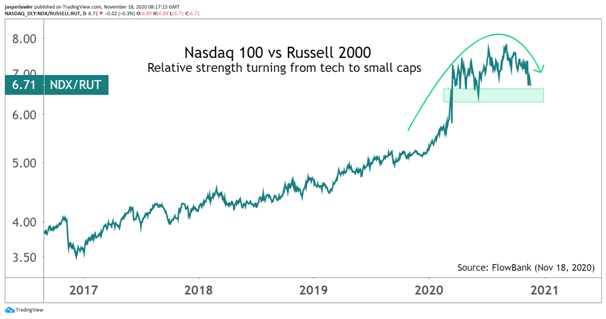Comparing the relative performance of the Nasdaq 100 and Russell 2000 indices as well as tech and financial stock ETFs offers some insight into a possible change in market leadership.
Must know
- The Nasdaq 100 made up of mostly growth and technology stocks has outperformed the Russell 2000 index composed of small cap stocks on a medium and long-term basis
- Relative strength charts demonstrate short-term outperformance in the Russell vs. the Nasdaq and a possible reversal in the medium term trend.
- Learn about using relative strength (RS) charts
Definition: Relative Strength
Relative strength is a form of momentum investing. It looks at how an asset has performed relative to another asset – or relative to a benchmark. If a trend of outperformance is present against the other asset, momentum investors can use that information to support the idea of taking a long position (buying the asset). If the asset in question is performing poorly relative to the other asset, it would detract from the viability of the investment idea.
What’s happening?
In this case, there has been a long period of the Nasdaq 100 outperforming the Russell 2000 and of tech stocks outperforming financial stocks. Throughout this period investors have been well served to avoid the small caps and financials and focus on megacap and technology stocks.
|
|
Nasdaq 100 |
Russell 2000 |
|
Year-to-date |
32% |
5.7% |
|
Over 3 years |
25% |
7% |
|
|
Technology ETF |
Financials ETF |
|
Year-to-date |
33% |
(8.3%) |
|
Over 3 years |
25.7% |
4% |
Now a shift in this relative out performance is taking shape. It can be seen in the charts above that since July this year, the trend in these two relative strength charts has plateaued. This could merely be a pause before the Nasdaq and tech stocks continue to show relative strength – or this could be the start of a new trend in which the Russell and financials are stronger.
Charts
The following charts show the relative strength of the Nasdaq 100 to the Russell 2000 and of the relative strength of the S&P 500 tech sector relative to the S&P 500 financial sector.

What is the relationship between these two charts? The common denominator is Big Tech. These stocks fit within the technology sector and are large cap. Financial stocks and small caps are typically cyclical because earnings improve when the economy is doing well.
The reasons one should have bought tech stocks and the Nasdaq over the past few years are now well documented. Big tech companies have grown very quickly often at the expense of other traditional areas of the economy.
Why might one think about switching to financial stocks? The principal reason is a belief that interest rates (bond yields) will move higher to adjust for move government debt issuance and higher inflation.
If governments continue to apply fiscal stimulus and if there is an effective vaccine that allows the global economy to normalise, then there is the chance for rapid economic growth over the next 12-18 months as economies make up the lost ground from during the pandemic. That gives small companies who have been outgrown by big tech firms the chance to compete again for investor funds.
How to play it
ETFs
EXXT - iShares Nasdaq 100 UCITS ETF
EQQQ - Invesco EQQQ Nasdaq-100 UCITS ETF
IWM - iShares Russell 2000 ETF
TWO - Vanguard Russell 2000 ETF
XLF - Financial Select Sector SPDR Fund
VFH - Vanguard Financials ETF
KBE - SPDR S&P Bank ETF
VGT - Vanguard Information Technology ETF
XLK - Technology Select Sector SPDR Fund
IYW - iShares U.S. Technology ETF
Read our next article: Jeff taking on yet another sector: Amazon Pharmacy





